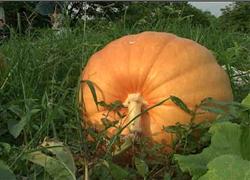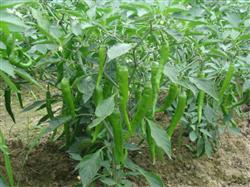Soil cultivation techniques of Giant Pumpkin

1, seedling cultivation: 1, nutrition bag seedling: seeds are sown in the greenhouse 6 weeks before planting. The first step: put the seeds into hot water of 60 degrees, stir for 15 minutes until the water temperature drops to 35 degrees, and then soak for 12 hours; the second step: put the soaked seeds into a hotbed for germination, the time is 24 hours, and wash the seeds about to sprout with warm water of 20 degrees for 12 hours. After 24 hours the seed coat broke open and sprouted 1 cm long buds, which entered the stage of seedling cultivation in nutrient bags. In order to ensure the quality of seedling, organic fertilizer and soil can be mixed according to the proportion and put into nutrition bags. Because the weather was very cold and the temperature was low, warm water of 30 degrees should be used when pouring bottom water. When the bottom water is sufficient. Put the budding seeds into the nutrient bag, soil about 0.5CM, then cover with 2CM thick fine soil, cover with plastic film, it is expected that one week will be unearthed. On the fifth day, individual ones have already been unearthed. At this time, the first unearthed ones and those not unearthed should be cultivated separately to facilitate temperature control. After 10 days of melon seedlings, low temperature squatting was carried out. Seedling to planting should not exceed 45 days, seedling in 35 days is the best time to land. When the seedlings grow to 4-5 leaves, transplant to the field, dig a pit with a diameter of 1 meter and a depth of 60CM, fill the pit with mature farm manure and soil according to the ratio of 1:1, after watering the soles, cover the pit with 5CM soil, plant the seedlings on the pit, then erect an arched shed with thin bamboo poles, buckle the mulch film, and pay attention to ventilation when the sun is sufficient at noon. Each pit has 1 plant, and the plant spacing is 3-4.5 meters. Because melon vines grow quickly, they need enough space to grow. 2. Direct seeding method: dig a pit with a diameter of 1 meter and a depth of 60cm, then fill the ratio of cooked manure and soil 1:1 to 3CM from the ground surface, dig a small pit with a depth of about 3-4CM, sow 1-2 seeds in each pit, cover the seeds with soft soil, cover the small soil bags 2CM above the soil surface, and sow at a spacing of 3-4.5 meters. Then set up an arched shelf with thin bamboo poles and buckle the mulch film. This will ensure that the lighting time and temperature, but also to prevent the wind blowing, sunny at noon when the regular release. When melon seedlings grow 4-5 leaves, remove one of the weak seedlings. When the minimum temperature of the day stabilizes at about 12 degrees above zero, remove the mulch. Second, field management: 1, is to do a good job of vine fixation and windbreak. In spring, the wind is strong in the north and typhoon in the south. The giant pumpkin leaves are big and the stems are fragile and easy to break. In order to prevent the melon seedlings from being blown over by the wind, first of all, the soil under the melon vines should be loosened with a small shovel, and the vines should be fixed on the ground with iron wires. After the melon vines take root, the iron wires should be removed. It is better not to press the vines with soil to prevent decay; Secondly, bamboo stems and waste agricultural film should be used around each melon to make a 60CM high windbreak cover. 2. It is necessary to timely pick, pollinate and retain the main vine. To remove the first female flower and pre-flowering tendrils, lateral branches to leave 2-3 leaves after the topping; the main vine grows to about 10 meters topping. At the beginning of July, two kinds of flowers were formed, namely male flowers and female flowers. Male flowers appeared first, then female flowers. Pay attention to the time when female flowers appeared. The female flowers are easily identifiable, and each flower has a green globose stalk at the base. These globose stalks are called ovaries. Usually remove the first female flower on each vine, and retain the second or third female flower, at this time the vine has grown to 2.5-3 meters, before 8 am to choose a fresh male flower, trim the outer petals, the pollen on the stamen will be shaken down to the stigma of the female flower. The female flowers produced in the future shall be removed; 3. When the young fruits of the second female flower and the third female flower grow to the size of a tennis ball, one of the largest melons shall be left behind, and the other shall be removed in time; 4. The position of sitting melon shall be flattened, slightly padded, and 1 square meter space shall be reserved. At this stage, the vine shall be trimmed. When the vine grows to 200 leaves, the new branches at the top and side shall be pinched to ensure the nutrient supply on the vine for the growth of pumpkin. When the vine grows roots at the petiole of each leaf, tear off the roots close to the pumpkin, thus providing room for the melon to grow, while removing the remaining female flowers, so that all nutrients can only supply one growth, then the pumpkin will grow at a rate of about 9 kg per day. Third, increase water and fertilizer management. Because the leaves of melon are large and many, organic fertilizer is applied once every 5-7 days, 50-70 kg per plant, 0.5 kg of nitrogen, phosphorus and potassium respectively. 5, topdressing, to be 1 meter away from the melon seedlings, surrounded by water, will be decomposed manure, add nitrogen, phosphorus, potassium compound fertilizer, poured into the manure ditch. For plants with fast growth speed, thick vines and large leaves, too fast fruit expansion and the appearance of melon king, special personnel shall be appointed to establish archives, focus on protection and special cultivation. Fourth, timely prevention of pests and diseases. After entering July. Aphids and powdery mildew are prone to occur when the weather becomes hot. In order to ensure the quality of green food, biological pesticides should be selected once a week as far as possible; powdery mildew should be prevented and controlled by pollution-free pesticides such as fenxiuning and lvbaoqing. 6, into the rainy season, to do a good job around the drainage of melon seedlings to prevent rotten melon phenomenon. At the same time, rat poison was sprayed around the pumpkins to prevent rats from damaging the pumpkins. 7, the environment is dry, easy to appear aphids and self-powder disease, with trichlorfon control; in case of blight, with green Baoqing, Sterling control. Pay attention to grasping the law, strengthen ventilation, pay attention to weeding, moderate watering, timely treatment of diseases and insect pests, prevention of diseases and insect pests in advance, and ensure the healthy growth of melon seedlings.
- Prev

Watering and fertilization methods of Pumpkin
Symptoms: damage to leaves and rachis. Leaf spots rounded to suborbicular or amorphous. The leaf margin is dark brown, the junction of the sick part is moist, when the humidity is high, the spot is dense with small black spots, serious leaf spot fusion, causing local death of the leaf. The rachis or flower is black and moist, or black-brown rotten. Pathogen: pumpkin leaves.
- Next

How to prolong the launch period of chili peppers in autumn
The area of autumn delayed pepper is large, so farmers are very concerned about how to make full use of the existing natural and facility conditions to obtain higher economic benefits according to the market situation. In production, it is suggested that farmers can take the following measures to achieve the goal: 1. Set up the second film in the greenhouse. In this way, it can be maintained until it is big in normal weather.
Related
- Where is it suitable to grow horseradish in China? it is expected to see the middle altitude horseradish in Alishan.
- How to prevent tomato virus disease reasonably? (Control methods included)
- Many people like to plant towel gourd on the balcony. What are the main points of this method and management?
- What crops can chili peppers be mixed with?
- Fertilization techniques and matters needing attention in Tomato
- What are the grafting techniques for peach seedlings in spring?
- Harm and control methods of root swelling disease of Chinese cabbage
- What are the pests of sweet potatoes? How to prevent and cure it?
- Symptoms, causes and Control methods of navel Rot in Tomato
- The cause of "Cucumber rotten bibcock" in Farmers' planting Cucumber and its Control Plan

